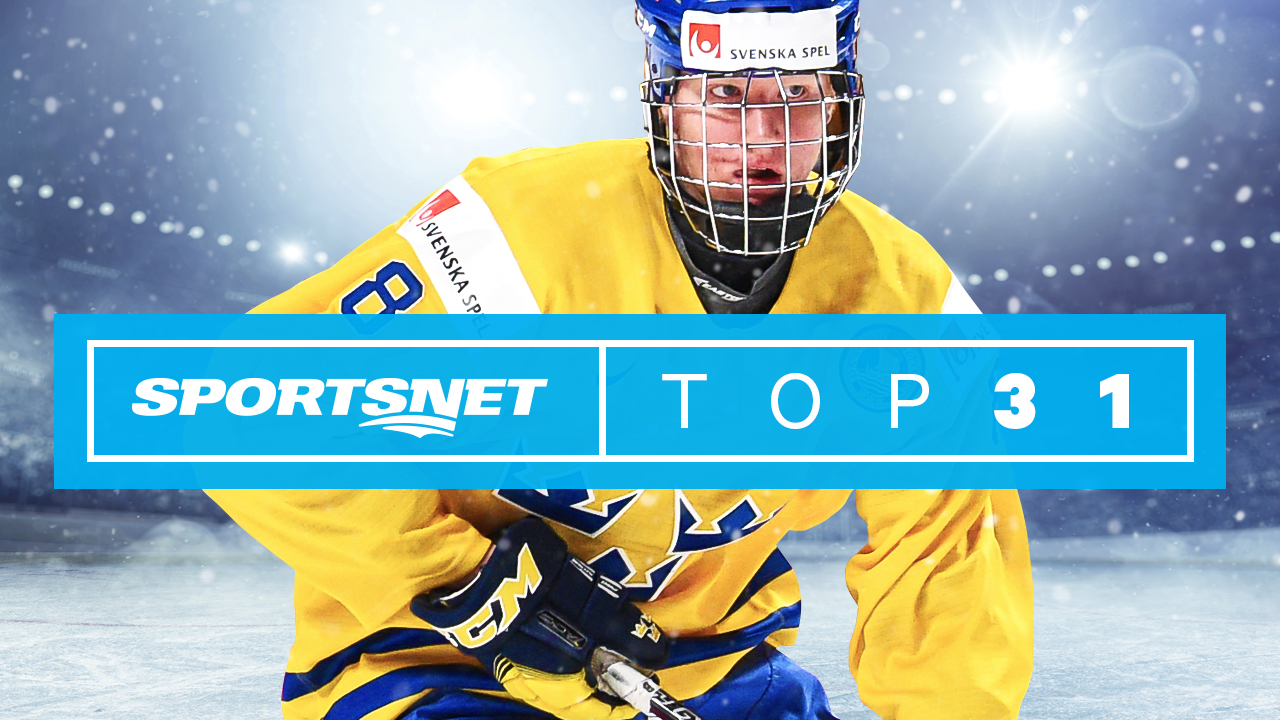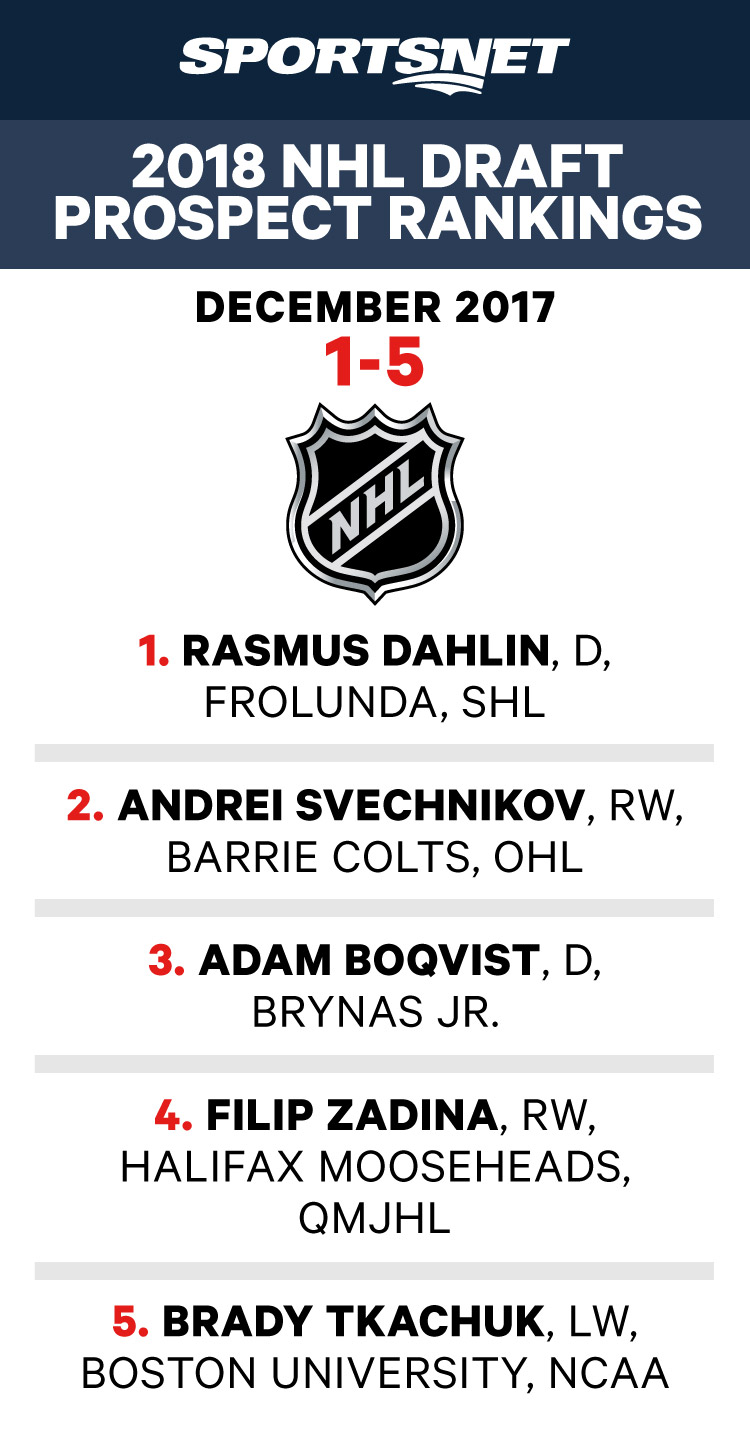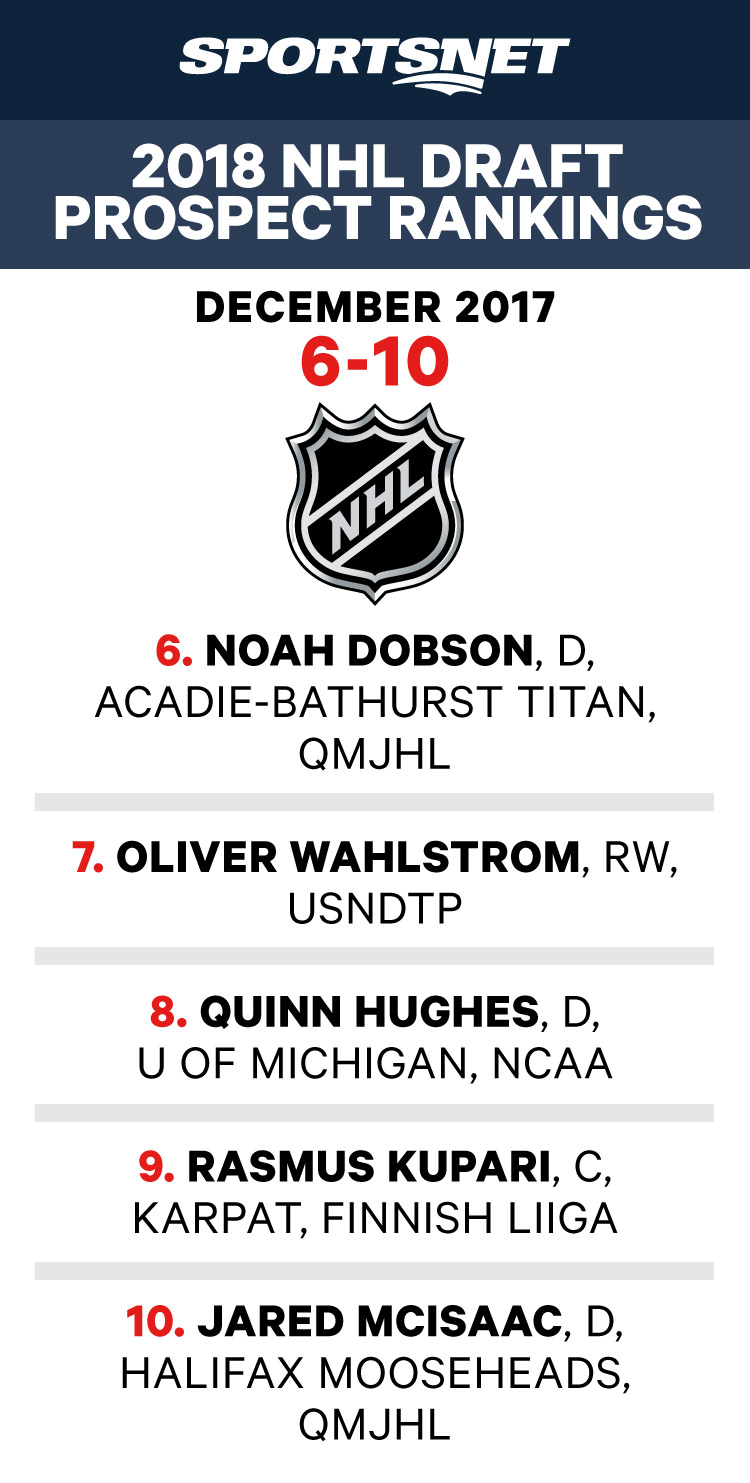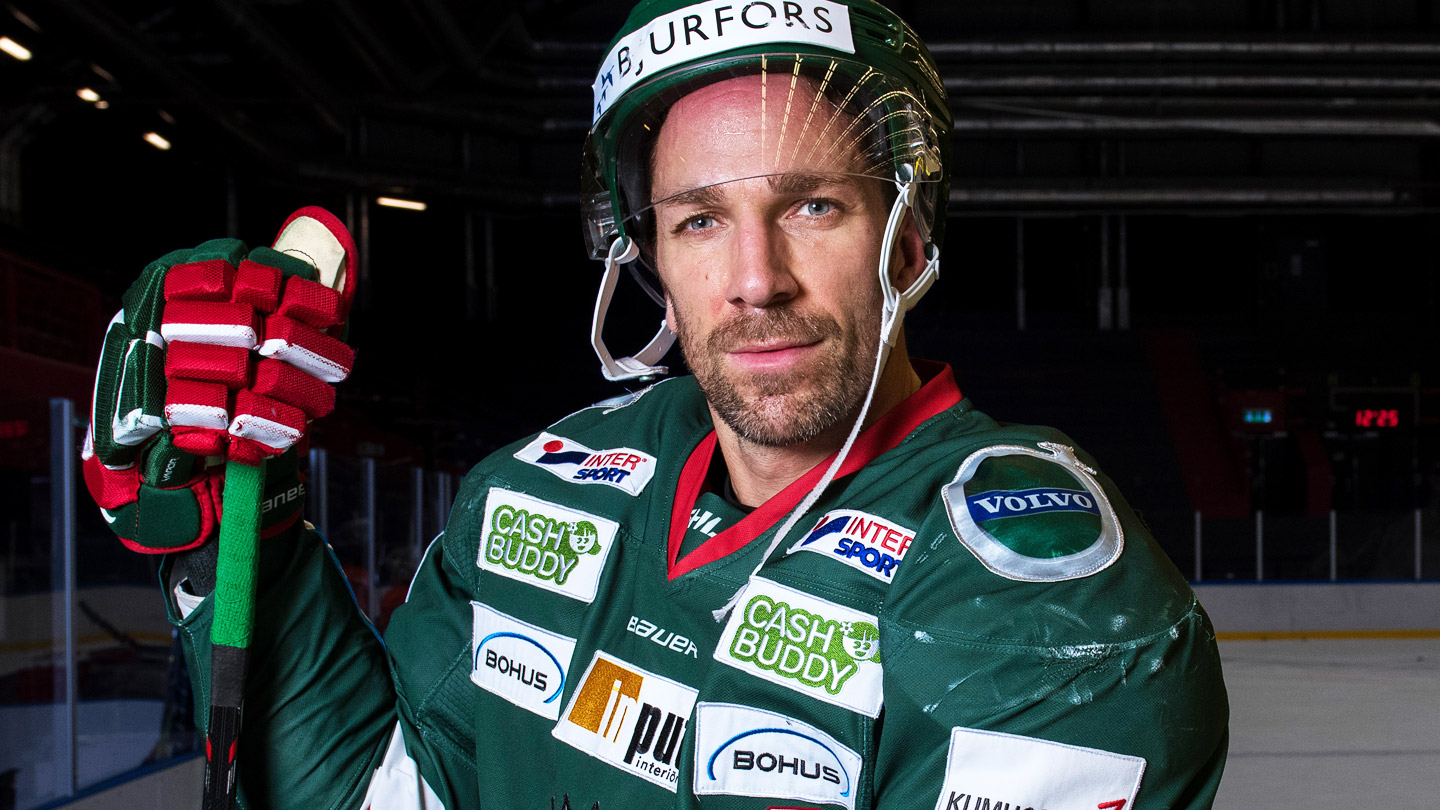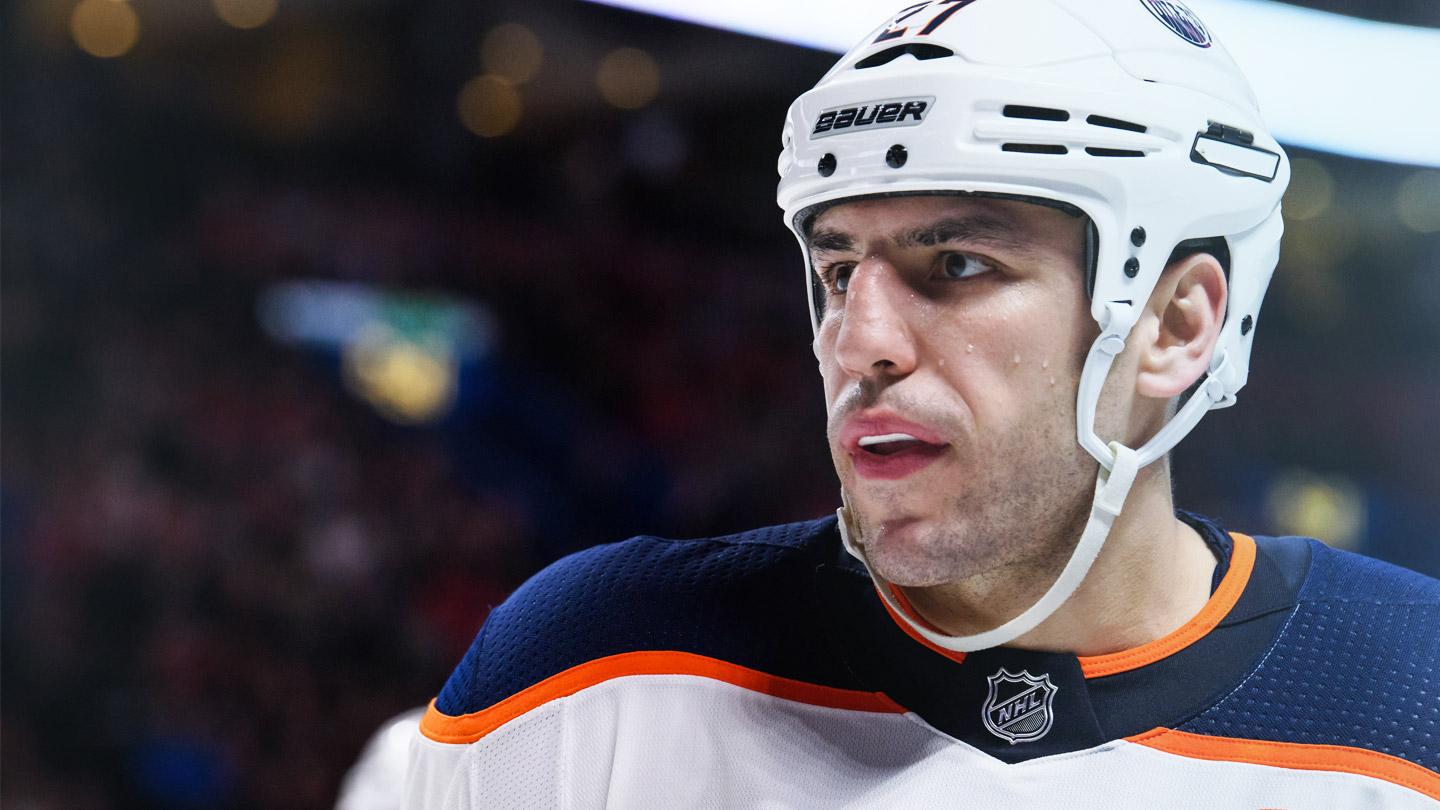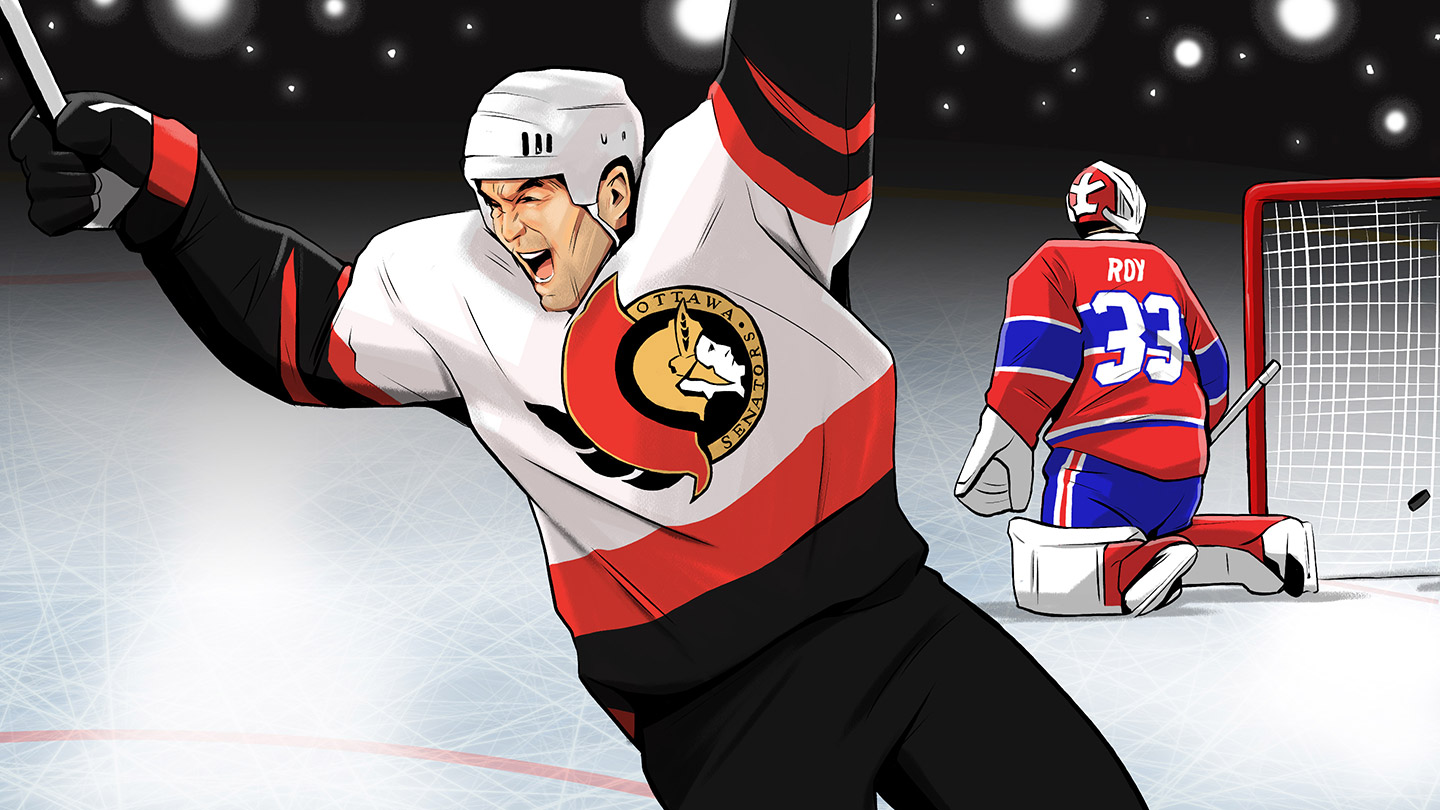On a cold, wet November night in Sweden’s second-largest city, the fans at one end of the Scandinavium don’t sit after the anthem. A hearty minority among the 9,000 in attendance, they stand for the entire game, chanting and singing. This phenomenon isn’t unique to the home team, Frolunda HC. It plays out everywhere in the Swedish Hockey League, and usually the beat of a kettledrum echoes in rhythm around the arena.
As a soundtrack, it doesn’t really raise the entertainment value but it offers a handy metaphor for the life and times of Rasmus Dahlin, a 17-year-old defenceman who has heard people in the game singing his praises and tried to tune out a steady drumbeat of hype in advance of the 2018 world junior tournament in Buffalo and the NHL Draft next June.
In the game, the timpani boom a little louder every time the puck is on Dahlin’s stick. Though he’s on the ice with many professional veterans in their late 20s and 30s, a few with NHL experience, not one moment on a single shift suggests that he’s the youngest player on the ice. Every 70-, 80- or 90-foot first pass on breakouts is on the tape, a couple lasered through traffic. When he jumps into the rush, he pulls away from chasing backcheckers with every stride. Dahlin’s out on the point on the first power play unit and the play goes through him on every possession.
Frolunda is in the middle of the pack of the 14-team league, although going through a rough patch, a few disappointing games, this should be a sure two points: The home team is in against Rogle BK, bottom-ranked and already out of the hunt for a playoff spot. Through two periods, though, it remains a one-goal game and very much in doubt. Not that Frolunda sits back, but Dahlin jumps up less frequently and not quite so aggressively. Only in the dying minutes does Frolunda start to pull away and in the last minute Dahlin wires a slapshot from the point that clangs off the crossbar.
In the dressing room, Dahlin is happy enough with the win and, as is typical, unimpressed with his performance. “I know that shot isn’t going in,” he says, speaking a little above a whisper, like he’s a rookie who must know his place in the room. “The rest of the game, it’s just one goal. You play the situation you are in. You don’t look at offence first. [My game] was maybe okay. I’ll watch tape with my coach tomorrow and know better.”
One veteran NHL scout who took in the game is much less equivocal: “I don’t ever think that anyone has locked up the No.1 slot in December. Only when the season is over and you’re listing the players am I comfortable saying who’s No. 1. Right now, though, he’s at the head of the pack. He’s the best defence prospect really since Victor Hedman but he has so much more to offer [than the Tampa Bay defenceman] with his mobility and puck skills.”
Likewise, the phenom’s teammates enthuse almost without reservation. Frolunda blueliner Jonathan Sigalet passes over the physical aspects of the game and points to Dahlin’s vision and instincts as the assets that set him apart from other prospects. “In a dozen pro seasons, I never played with or against a defenceman who has anything close to his ability to read the play out there and his sense of time and space,” says Sigalet, a Vancouver native who spent a decade in the AHL and KHL before heading to Sweden in 2014. “I’m not talking about young defencemen. I’m talking any defenceman. His skating is off the charts. So are his skills. But there’s some stuff that you can’t teach or work on and are can be hard to describe but you know it when you see it.
“And really, it’s hard to put into words how hard it is to break into this league for a kid barely 16-years-old like Rasmus was last season. And there were times he made it look easy.”
Of course, on that last point, it went well beyond the ease with which Dahlin stepped into the Frolunda lineup. Even at 16, he was no ordinary middle-of-the-roster player. Nightly he produced the stuff of highlight reels. His outrageous undressing of veteran defencemen with McDavidesque dangles left opponents and scouts scratching their heads. Did he really just do that? And exactly how did he do that? Dahlin’s emergence over the course of last season moved him to the head of the pack of 2000-birthdays. He’s poised to be the first true millennial superstar, at least as far as birth certificates go.
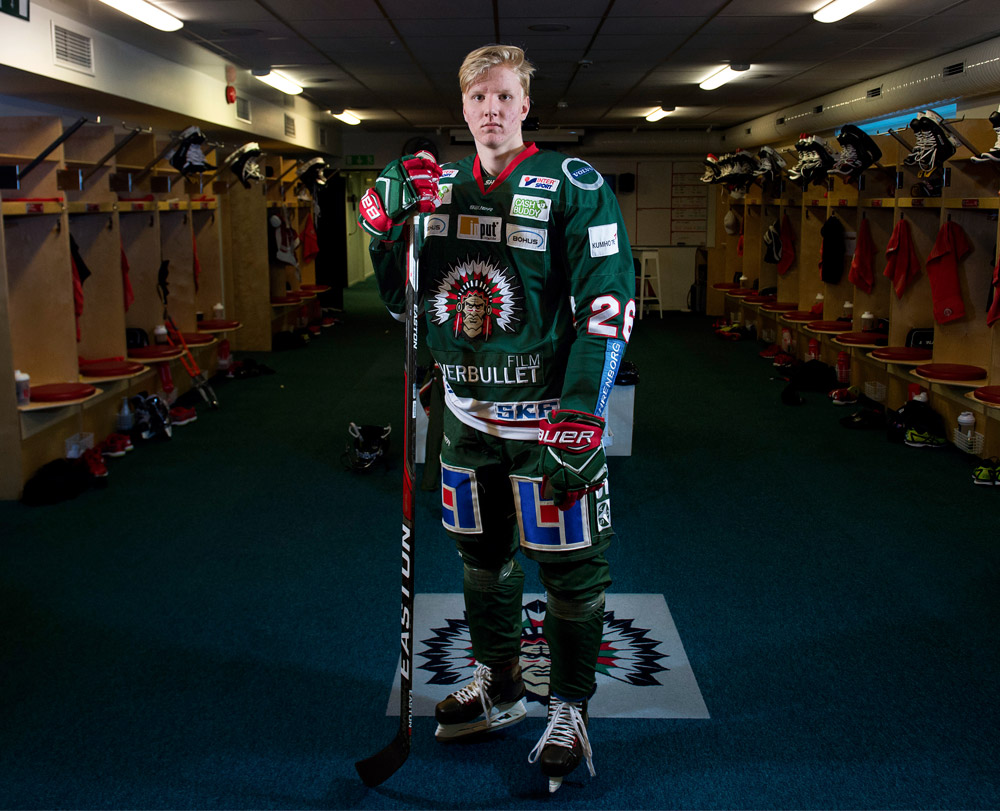
Rasmus Dahlin is in line to become just the third defenceman picked first-overall in the past 22 seasons: Erik Johnson in 2006 and Aaron Ekblad in 2014. The former is considered one of the big whiffs in recent draft history (the St Louis Blues passing over Jonathan Toews, Nicklas Backstrom and Phil Kessel for a blueliner out of the U.S. under-18 program); it’s too early to declare the latter a big win despite Ekblad’s Calder Trophy and some promising returns.
Conventional wisdom holds that, as the NHL scout at the Scandinavium suggests, comparable prospects would be Hedman or Los Angeles’s Drew Doughty, both second-overall picks who would have had their names called first in drafts lacking future All-Star centres (John Tavares and Steven Stamkos respectively). Yeah, there are rumbles that Andrei Svechnikov, a Russian right winger with the Ontario League’s Barrie Colts might be 1A and could overtake Dahlin. That, though, seems to be the contrarian’s take or perhaps the belief that, in today’s NHL, when facing a choice between an elite blueliner and an equally elite forward, the tie always go to the talent up front.
Of course, many of those listening to the timpani have not yet seen Dahlin in person. Maybe some saw him at the under-20s in Montreal last year, but really they couldn’t get much more than a glimpse. At barely 16-and-a-half, Dahlin was the youngest player in the tournament and with a snipe from the point against Denmark he became the first player born in the 2000s to score a goal at the world juniors. Still, the Swedish team’s coaching staff gave Dahlin third-pairing ice time, a virtual cameo appearance at the event. In a 5-2 loss to Canada in the semi-finals, he was on the ice for barely six minutes, even though a few in the NHL scouting community thought the team ticked up every time he came over the boards in a desperate push to score late in the game.
No doubt the Swedes will be leaning a lot more heavily on Dahlin at the tournament in Buffalo this month, just as it did with Hedman and Erik Karlsson back in 2009. “It was an amazing experience [in Montreal] but this tournament has been a goal for me that I thought about during the summer,” Dahlin says, but then catches himself. “Of course, Frolunda and the SHL is the main thing right now… my focus. But you always think of the chance to play for your country.”
In eras past, Dahlin would be one of those well-known names who would be sight unseen outside of Sweden, but these days, hockey fans have a chance to feast on a steady diet of video mixtape highlights from his play in the SHL. By the time the draft drifts around, some of these packages are bound to have upward of a quarter-million views.
It’s hard to say, based on context, whether this season’s are more impressive than last season’s. And no doubt clips from the world juniors will be woven in there, maybe even the world championships — maybe even the Olympics. There’s no telling. No, a 17-year-old shouldn’t be playing at the Olympics, but really it doesn’t seem so much more improbable than a 16-year-old stepping into the SHL and making electrifying end-to-end Orr-like rushes.
Dahlin is also in line to be the first Swede to go No. 1 since 1989, when the Quebec Nordiques selected future Hockey Hall of Famer Mats Sundin. According to Anders Hedberg, former WHA and NHL star and a member of the Swedish and IIHF Hockey Halls of Fame, Dahlin is a prospect who couldn’t have emerged from the SHL or national programs 20 years ago. Says Hedberg: “After Peter Forsberg, there was a period of 10 years or so when we produced very few players in Sweden — Henrik Lundqvist, Henrik Zetterberg, the Sedins, but really very few. We didn’t develop the skill players because of the game that was played here… [was] very conservative, so negative; no risks, no speed, safe, possession hockey without imagination or creativity.
“Teams played a 1-3-1 system, defence first. It would get some results internationally because it’s so hard to play against, but it was terrible for development. If Rasmus Dahlin came along then, there was no way that he would have been allowed to play the game you see him play now. No way he’d be encouraged to be so aggressive with the puck. Eventually the Swedish hockey federation came to the conclusion in the late-90s and early-2000s that we had to rethink the way the game is played. We had to let them play and not hold them back.”
Hedberg suggests that the unintended by-product of these changes has been an unprecedented emergence of players along the blueline. “Our best young forward would be Filip Forsberg but there are lots of defenceman, from Erik Karlsson and Viktor Hedman in the beginning to Oliver Ekman-Larsson and Mattias Ekholm and Hampus Lindholm. We encouraged forwards to take chances and it wound up making our defencemen so much better. We saw that in our junior leagues and with Rasmus we’re seeing that at the highest level in the country.”

Rasmus Dahlin’s backstory is a piece with many prospects — there are only so many templates and almost no one stands as unique. He grew up the younger of two brothers in Trollhättan, a town of 45,000 a 90-minute drive from Gothenburg. He was on skates at the age of two. A bandy stick was as likely to be in his hand as a hockey stick in those early days — in Trollhättan, bandy, an 11-a-side outdoor game with a ball in place of a puck, reigned among kids.
Still, it was natural that Dahlin gravitated towards hockey and not just because his brother, Felix, played the game. No, Martin, Rasmus’s father, played in the Swedish third division (about as far removed from the old Swedish Elite League as the ECHL is from the NHL) and has for more than 10 years worked as a consultant for the Swedish hockey federation — he tours regional organizations and oversees the quality and education of coaches. In this way, his son was born right into a Swedish hockey establishment that was evolving for the better.
Not that Rasmus Dahlin became the special project of the Swedish hockey-industrial machine. Anything but. “I always loved the game and I followed my brother Felix to the arena,” he says. “The game always made me happy. I didn’t think about playing pro hockey. I played to be with my friends, just to win games. My brother is five years older than me and he had to stop playing because of arthritis so I am playing for him.”
Martin Dahlin suggests there was no pressure on his younger son to work on hockey to the exclusion of other sports and other aspects of life. “Rasmus played all sorts of games,” he says. “He always played soccer. He was even playing a couple of years ago. He played bandy and liked table tennis and cycling. And Rasmus always had friends and a social life. He was a quiet kid when he was young. But it was always hockey that he came back to.”
Rasmus can’t point to one season when he broke through, not one stage where he went from just a player to the dominant player in a youth league. “When we moved to Gothenburg [and joined] the Frolunda program, there were always players around me who had lots of talent, very good players who were very hard to play against,” he says. “I just worked on my game and played.”
Properly humble, but Dahlin understates the case. Says Joel Lundqvist, the captain of Frolunda’s pro squad and the kid’s favourite player growing up: “We had heard about this young player at the academy, like you always do. That was Rasmus. Until you see him you don’t know, but everyone was talking about this special talent.”
In the fall of 2016, Frolunda and the Dahlins faced a very tough decision: Should Rasmus eschew junior hockey to skate with pros in the SHL? It seemed to be a decision fraught with risk. At six-feet and maybe 160 pounds, could he physically stand up or would he suffer an injury against the bigger, stronger men? If he didn’t make the grade, would his confidence take a heavy blow? “I played up [in age] before but of course when you’re 16 and they are pros it’s a big change,” Dahlin concedes.
Yet Martin Dahlin actually saw it as a no-lose proposition. “I didn’t know if he would be able to do it,” he says. “You can never know. If he couldn’t play with the team, he wouldn’t be hurt by it. He would be able to go back and play with players his age. There would be no risk, no damage.”
There wasn’t a lot of mystery about Dahlin’s ability to stick with the big club. “At that first practice, we hear, ‘Yeah, this is that kid they were talking about and he’s skating with us,’” Lundqvist says. “After just a couple drills in practice, 10, 15 minutes, we’re thinking, ‘Yeah, this is something special.’ There really wasn’t any question about his ability to skate with us. All that was out there was, ‘How good can he really be?’ Every practice, every game, there was a moment when you looked and said, ‘Did he just do that? He’s how old?’”
Dahlin’s numbers with Frolunda last year didn’t blow anyone away: a goal and three points in 26 games. And he wasn’t the first 16-year-old to play at this level. The last one who did, Adam Larsson, was, like Dahlin, many scouts’ projected first-overall pick, just on the basis of his ability to keep up with the pros as an 11th-grader. Says one NHL scout: “Larsson and Dahlin are just different cases. Larsson had size and strength and was much more stay at home, nothing like Dahlin with the puck and on the rush. Larsson was solid but he had a ceiling — he winds up dropping [to fourth overall] in his draft year because you knew just how close he was to the best he could ever be.
“Dahlin is creative. He’s developing his game without the puck in his own end but with the puck he’s so dynamic. Like [Erik] Karlsson, maybe, but so far ahead of Karlsson at the same age.”
Inevitably, fans looking at Dahlin will draw comparisons to Karlsson and would regardless of nationality. Dahlin admits to being a fan, but balks at the idea that he models his game after Karlsson or any players. In fact, he admits that he spends more time watching the elite young NHL forwards. “It’s amazing to see what McDavid and Matthews can do,” he says. (Yes, if you need to feel any older, consider that Dahlin is the brightest star of a generation of players who grew up watching Connor McDavid.)
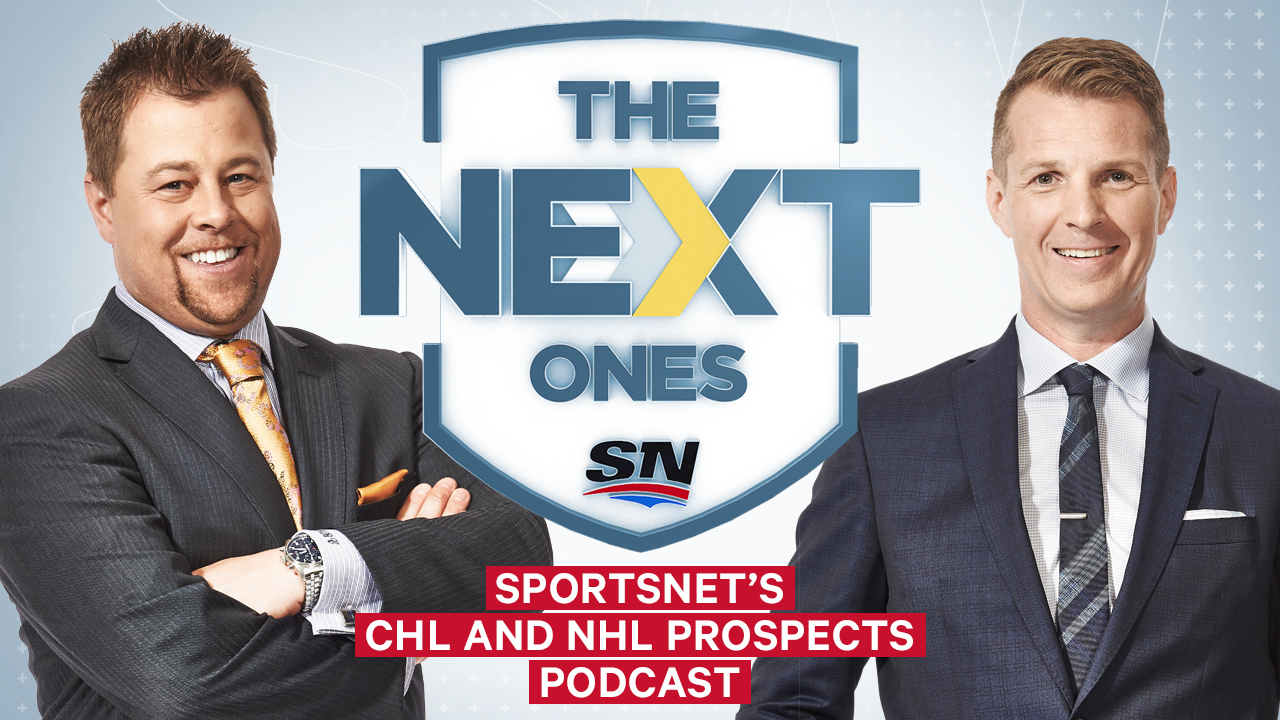
Jeff Marek and Sam Cosentino host the best junior hockey podcast around.
Apple Podcasts | Podcatchers | On Demand
This year Dahlin’s game has taken off. Working out at the Frolunda academy he has packed on more than 15 pounds of muscle since first stepping on the ice with the big club and might measure six-foot-two when he checks into the NHL combine weeks after his 18th birthday. “He’s much stronger,” says Pär Johansson, the assistant coach who handles Frolunda’s blueline corps. “This summer was the first time he did real professional off-season training — other years he skated, went to camps, but the real hard work, this was the step up. And really he was not [physically mature enough] to put real muscle on like he will next summer or in two or three years.”
Johansson also suggests that Dahlin’s confidence has grown in his second season with the big club. “Rasmus knows the players around him and on the other teams,” he says. “He has a great understanding of the game but now it’s also the understanding of a league. I could coach a long time and never have a player like Rasmus again… a young man who can do almost anything but is still learning the game. Sometimes I have to remind him, enjoy all of this. Be a kid. Get out of the gym and go to school — he’d spend his whole day here. He is so focused on playing well and being the best player he can, I have to remind him: Have fun.”

Two days after the win over Rogle, Frolunda routs Linkopings HC 5-1 and the drumbeat and cheering dies down, Rasmus Dahlin and his teammates stay on the ice for a special presentation: The team is raising money for charity by auctioning off game-worn sweaters. In this business of investing in hockey futures, it shouldn’t surprise that Dahlin’s sweater drew the high bid, over $7,000. When the wunderkind sheds the sweater to polite applause and passes it on to the lucky purchaser, he manages to look sheepish about the exercise, as if he can’t fully process the idea that his sweater would be a much-valued souvenir down the line.
After all, there might not be so very many to go around — first-overall picks are almost always fast-tracked to the NHL just months later. In fact, the last who was held off for a season was Erik Johnson back in 2006. That said, unlike players coming out of major junior, Dahlin isn’t looking for challenges above teenage competition — he’s been playing in a men’s league for two seasons, in the SHL. Yeah, it might not be as strong a league as the KHL but still Frolunda faces the best in Europe in the Champions League play.
Count Hedberg among those who think that rushing Dahlin into the NHL next season is an ill-advised risk. “Whoever drafts Rasmus, I really hope they take their time with him,” he says. “He is young and needs time to grow. Put him in a position to succeed.”
We can only guess at how next season will play out for the phenom who is known to hockey fans in North America mostly through YouTube. They’ll get a much better sense of his game when the IIHF under-20s play out in Buffalo in the coming days. Said Dahlin’s Frolunda teammate Lias Andersson, the New York Rangers’ first-round pick last June: “People are going to see just how great he is in that tournament. At the world-junior [level] he is a superstar. One day I’ll be telling people that I played with a Hall of Famer.”
For futures foreseeable and unforeseeable, the drums will keep on beating for Rasmus Dahlin.

